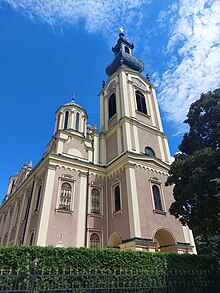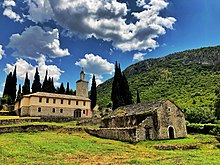
The Serbian Orthodox Church is one of the autocephalous Eastern Orthodox Christian churches.

The Bulgarian Orthodox Church, legally the Patriarchate of Bulgaria, is an autocephalous Eastern Orthodox jurisdiction based in Bulgaria. It is the oldest Slavic Orthodox church, with some 6 million members in Bulgaria and between 1.5 and 2 million members in a number of other European countries, Asia, the Americas, Australia, and New Zealand. It was recognized as autocephalous in 1945 by the Ecumenical Patriarchate of Constantinople.

The Eparchy of Zahumlje, Herzegovina and the Littoral is an eparchy (diocese) of the Serbian Orthodox Church with its seat in Mostar, Bosnia and Herzegovina. It has jurisdiction over the region of Herzegovina, the littoral region of southern Dalmatia in Croatia and a small part of Montenegro. Since 2018, the bishop of Zahumlje and Herzegovina has been Dimitrije Rađenović.

The Serbs of Bosnia and Herzegovina are one of the three constitutive nations of the country, predominantly residing in the political-territorial entity of Republika Srpska. They are frequently referred to as Bosnian Serbs in English, regardless of whether they are from Bosnia or Herzegovina.
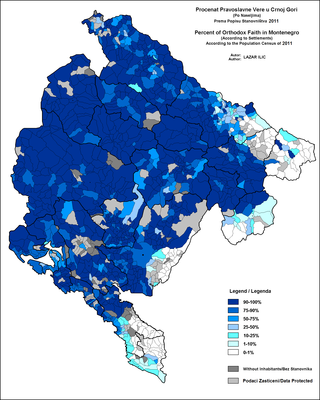
Eastern Orthodoxy in Montenegro refers to adherents, religious communities, institutions and organizations of Eastern Orthodox Christianity in Montenegro. It is the largest Christian denomination in the country. According to the latest census of 2011, 446,858 citizens of Montenegro (72.07%) registered as Eastern Orthodox Christians. The majority of Eastern Orthodox people in Montenegro are adherents of the Serbian Orthodox Church. A minor percentage supports the noncanonical and unrecognized Montenegrin Orthodox Church, which has the status of a religious non-governmental organization (NGO) since its founding in 1993.

The Metropolitanate of Zagreb and Ljubljana is an Eastern Orthodox eparchy (diocese) and one of the five honorary metropolitanates of the Serbian Orthodox Church. The headquarters of the metropolia is located in Zagreb, Croatia, and its jurisdiction covers northern Croatia and the entire territory of Slovenia.

Serbian Orthodox Eparchy of Slavonia is an eparchy (diocese) of the Serbian Orthodox Church encompassing areas of western and central Slavonia, in modern Croatia. Since 2014, the Eparchy is headed by bishop Jovan Ćulibrk.
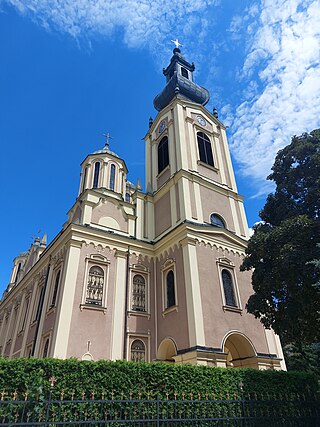
The Metropolitanate of Dabar-Bosnia is a metropolis of the Serbian Orthodox Church in Bosnia and Herzegovina, seated in Sarajevo. Since 2017, Metropolitan of Dabar and Bosnia is Hrizostom Jević.

The Eparchy of Banja Luka is an eparchy (diocese) of the Serbian Orthodox Church with its seat in Banja Luka, Bosnia and Herzegovina. It has jurisdiction over the north-western regions of Bosnia and Herzegovina.

The Serbian Patriarchate of Peć or just Patriarchate of Peć, was an autocephalous Eastern Orthodox Patriarchate that existed from 1346 to 1463, and then again from 1557 to 1766 with its seat in the Patriarchal Monastery of Peć. It had ecclesiastical jurisdiction over Eastern Orthodox Christians in Serbian Lands and other western regions of Southeastern Europe. Primates of the Patriarchate were styled Archbishop of Peć and Serbian Patriarch.

The Eparchy of Zvornik and Tuzla is an eparchy of the Serbian Orthodox Church with its seat in Bijeljina, Bosnia and Herzegovina. It has jurisdiction over the north-eastern regions of Bosnia and Herzegovina. Since 2017, Bishop of Zvornik and Tuzla is Fotije Sladojević.
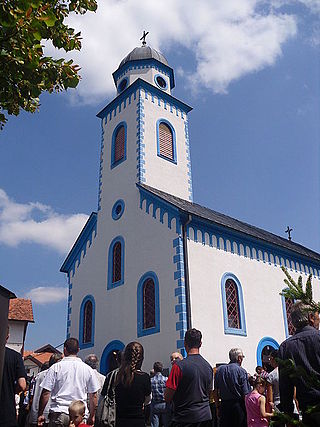
The Eparchy of Bihać and Petrovac is an eparchy (diocese) of the Serbian Orthodox Church with its seat in Bosanski Petrovac, in Bosnia and Herzegovina. It has jurisdiction over the western regions of Bosnia and Herzegovina. Since 2017, Bishop of Bihać and Petrovac is Sergije Karanović.
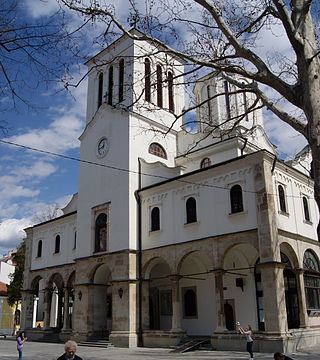
The Eparchy of Niš is an eparchy (diocese) of the Serbian Orthodox Church with its seat in Niš, in Serbia. It has jurisdiction over the south-eastern regions of Serbia. Since 2017, Serbian Orthodox Bishop of Niš is Arsenije Glavčić.
The Eparchy of Mukachevo and Prešov was an Eastern Orthodox diocese (eparchy) of the Serbian Orthodox Church, that existed from 1931 to 1945. It had jurisdiction over regions of Slovakia and Subcarpathian Rusynia, at that time parts of former Czechoslovakia. Its seat was in Mukachevo.

Petar Zimonjić was a bishop of the Serbian Orthodox Church serving as the metropolitan of Dabar-Bosnia in the Kingdom of Yugoslavia from 1920 until the beginning of World War II.
Nikolaj Mandić was a Serbian Orthodox theologian, Metropolitan of the Metropolitanate of Dabar-Bosna (1896-1907) and Metropolitan of the Diocese of Zvornik-Tuzla from 1892 to 1896.
Evgenije Letica was a Serbian theologian, Metropolitan of the Eparchy of Banja Luka (1900-1907) and Metropolitan of Dabar-Bosna.
Grigorije Živković was a bishop of the Serbian Orthodox Church.
Atanasije Ljubojević or Ljubović was the Serbian Orthodox Metropolitan of Dabar-Bosnia from 1681, and then the bishop of the Orthodox Serbs in the Venetian areas in the Dalmatian hinterland and the Habsburg areas in Gornja Krajina. He is recorded in history as the only diocesan archbishop from the time of the renewed Serbian Patriarchate (1557-1766) who performed the diocesan service under Turkish, Venetian and Habsburg rule.

Hrizostom Jević is a Bosnian prelate of the Serbian Orthodox Church. He has been the metropolitan bishop of Dabar-Bosna since 2017. Jević, formerly a monk of the Krka monastery, has also served as bishop of Bihać and Petrovac (1991–2013) and Zvornik and Tuzla (2013–2017).
